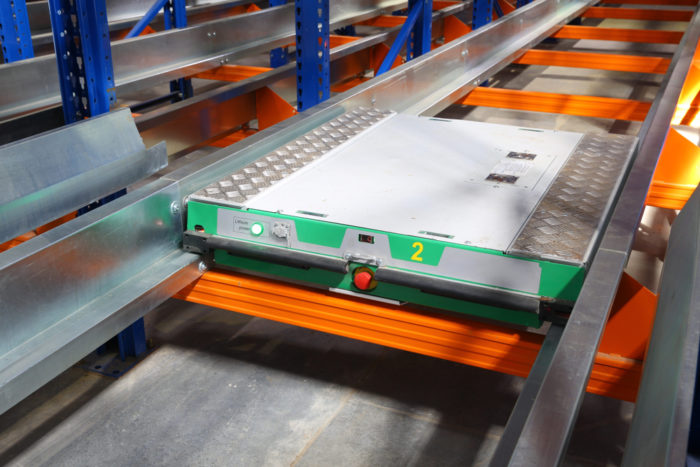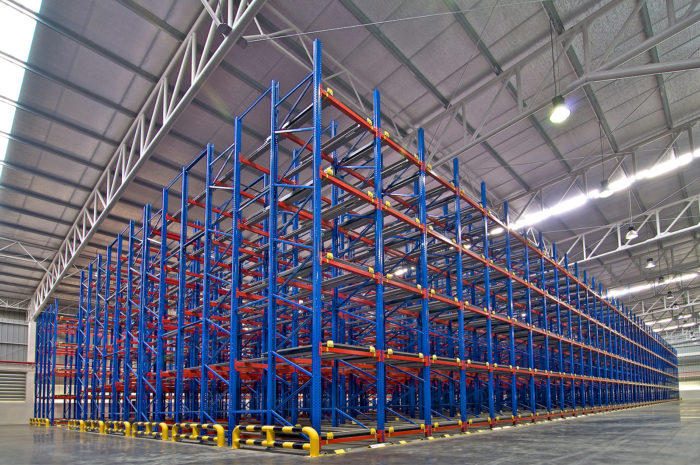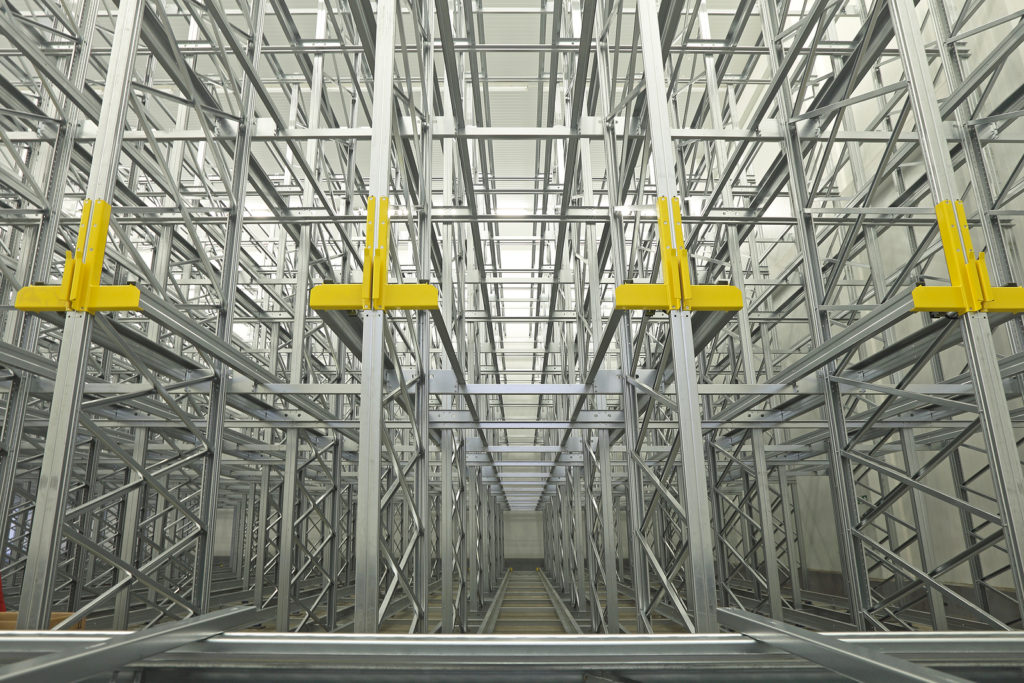Key Takeaways:
• The supply chain is very complex, with many moving parts.
• Deep lane storage systems can help simplify inventory and cube utilization within a facility, but they have pros and cons.
• Supply chain managers should consider whether this solution is right for them.
• Warehouse aisles have been shrinking to accommodate more products, which can lead to safety issues.
• Deep lane storage also has advantages, such as the ability to store a high density of goods in a small area.
• Such systems are typically also conducive to automation, such as implementing autonomous guided vehicles.

It would be an understatement to say that the modern global supply chain is complex. Numerous products or raw materials from widespread locations arrive at the same facility to be processed and then shipped to locations across the nation and around the globe. Managing the locations of all these materials and products and keeping them separated, yet easily accessible, is no easy feat.
A deep lane storage system can simplify this process. High density storage maximizes slots for inventory by improving cube utilization within a facility, while also providing separate channels for each stock keeping unit, or SKU. This keeps SKUS separate while speeding up slotting, picking, and throughput. This type of storage, called deep lane storage, is also among the simplest types of systems for automation. But this type of setup can lead to compromises in flexibility. Implementing a deep lane storage system requires planning, equipment, and time, and it can be challenging to modify with evolving circumstances. Supply chain managers would be wise to consider both the benefits and disadvantages to determine whether a deep lane solution is right for their facility.
How Deep Lange Storage Solves Issues with Traditional Layouts

In most warehouses and fulfillment centers, racking systems divided by aisle contain pallets loaded with products. The aisles permit forklifts to access storage slots. Although this is the typical design, it can present inherent challenges. For example:
- Wasted Space: A large portion of the typical facility’s square footage is dedicated to aisles, which represent empty space that isn’t given the enterprise a return on its investment. Aisles in many facilities have therefore diminished in size, but that can present safety hazards.
- Lost Inventory: Employees with access to all the slots in a facility may mistakenly place products in the wrong slot or treat it as a quick solution during unloading. In turn, employees may have to track down misplaced inventory later, thus slowing down product picking.
- Employee Safety: By their very nature, traditional facility layouts tend to have issues with safety. Collisions can occur due to multiple forklifts and employees walking in the same aisle. Racks may be constructed to their maximum height limit, and forklifts can be less stable at higher levels. Unfortunately, forklifts tipping over and dropping pallets isn’t uncommon in warehouses and is dangerous.
Deep lane storage systems eliminate aisles and all of their issues completely. Pallets are brought onto one end of a continuous block of rocks, and a pallet shuttle or a “pallet mole” carries the pallet into the following slot. This system allows for a higher number of slots per square foot and only calls for forklifts at the input and output ends of the pallet racks. Because of this, fewer forklifts are needed and have less opportunity to interfere. Deep lane storage provides many benefits for the warehouse.
The Advantages of High-Density Deep Lane Storage
The first advantage of deep lane storage is the high number of products that can be stored in a small area. This allows for easier organization of logistics channels and maximizes facility square footage. In the supply chain today, every SKU and delivery method represents a channel. For example, a consumer good, such as boxed cereal, has a channel that charts it from producer to grocery retailers. However, if home delivery is part of that equation, then two channels are needed in the same facility for the same SKU. In an ideal world where omnichannel services are the goal, designating a lane for every channel may be the greatest accomplishment of deep lane storage systems.
Deep lane storage also offers the ability to designate multiple lanes for the same SKU — with the end destination being the only distinction between lanes. This makes completing multi-channel orders with facility-picking best practices much easier. A deep lane storage system provides many other advantages, like:
- Easy Automation: Deep lane storage systems are automated — therefore easily integrate with other automated systems. The pallet shuttles used in deep lane storage are automated, and achieving a fully automated system is a matter of equipping every lane with a permanent shuttle and ensuring they act autonomously.
- AGV Compatibility: Deep lane storage systems’ input and output zones are fixed; This makes it easier to implement Automated Guided Vehicles (AGVs) and allows for the possibility of other kinds of facility automation — reducing labor costs.
- Linear Throughput: SKU storage only works in two ways in a deep lane storage system. Storage is either 1) in a First-In, First-Out (FIFO) basis with input on side of the racks and output on the opposing, or 2) it is a singled-sided Last-In, First-Out (LIFO) method with both input and output on the same side. Both methods make product fulfillment easier. Employees only must pull the next available pallet at the output regardless of the setup.
Additionally, since a pallet shuttle moves from one end of the racks to the other faster than a forklift, deep lane storage allows higher throughput than any other storage system. The combination of high throughput, automation capability, and easy-to-manage multiple channels makes deep lane systems the clear choice for many busy facilities, warehouses, and distribution centers. Of course, there are a few potential disadvantages to deep lane storage systems that should be noted.
Making the Most of Deep Lane Storage Systems
Scaling is one of the drawbacks to deep lane storage. While high-density warehouse storage systems can be scaled up, it isn’t a fast process by any means. New racking must be installed, warehouse management software needs to be programmed, and automated must be tested beforehand. Installation of the expansion may interrupt operations. Plus, deep lane storage systems don’t scale down. If a SKU experiences a large different in demand, lanes could sit empty or have to be designated for different SKUs. The possibility of this must be accounted for in planning stages.
Facility managers thinking about adopting deep lane storage should also note that its system does not allow ready access to areas within the racks. If something doesn’t go as planned with inventory in the rack or with pallets, the only option is to pull all the inventory from the lane and all adjacent lanes to repair or clean up the issue. The high density and throughput of the system also means that doing this can be a detrimental disruption — costing money and time.
To evade these potential problems, it’s key to have reliability at the load unit level. Pieces of wood, dismantled pallet boards, and random nails that can damage inventory packaging or equipment are unacceptable in a deep lane storage system. One way to prevent a disruption is to choose a shipping platform that won’t break down and damage the system. Therefore, plastic pallets are the ideal shipping platform for an automated, high-density facility. Plastic pallets are constructed uniformly and with high-quality plastic; they don’t use metal fasteners that may come loose and damage machinery. Plus, since they have consistent weight and size, plastic pallets pair well with the automated systems of today. Overall, a plastic shipping platform is the top-tier option for keeping a deep lane storage system working at its highest efficiency.
Key Q&A:
What is a lane in a warehouse?
A lane in a warehouse or facility is a designated pathway for the moving of inventory. It often refers to a specific row where products are stored or accessed.
What is single deep racking?
Single deep racking is a storage system where pallets are placed one behind the other in a single row — allowing direct access to each pallet.
What are the different types of racking?
Different types of racking include pallet racking, cantilever racking, drive-in racking, and selective racking, among others — each designed for specific storage needs.
What is the difference between racking and shelving?
Racking typically refers to a system for storing pallets or heavy items in industrial settings, while shelving is more common in retail or office environments for lighter items.
The iGPS pallet pool offers a durable and reliable plastic pallet that is ideal for deep lane storage systems. To switch to a rental pallet that helps you get the most out of your high-density facility, give our team a call at 800-884-0225, email a specialist at switch@igps.net, or visit our contact page.



